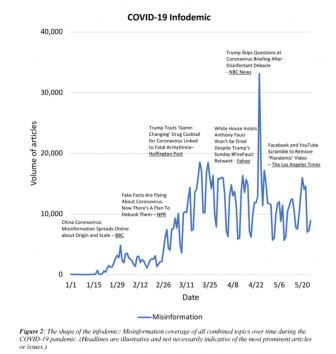Cornell study: 38 percent of COVID-19 misinformation fueled by Trump
ITHACA, N.Y. — A Cornell University study published Last week shows that President Donald Trump was the leading purveyor of misinformation during the ongoing coronavirus pandemic.
The study analyzed 38 million articles published by traditional English-language news media from all over the world from Jan. 1 to May 26, 2020 using Cision Global Insights, and found 1.1 million instances of coronavirus misinformation. Of those 1.1 million articles, 37.9 percent included mentions of Trump in relation to misinformation, making him easily the leader, at least in the English-language media landscape. Fact-checking articles, which were counted among the 1.1 million since they deal with misinformation directly but separated from others by using key terms, made up just 16.4 percent of the total. It was lead-authored by Sarah Evanega, the Director of the Cornell Alliance for Science.
“We conclude that the President of the United States was likely the largest driver of the COVID-19 misinformation ‘infodemic,’” the paper states. It continues on to blame non-thorough media coverage as partially to blame for the magnitude of the infodemic as well.
YOUR LOCAL HEALTH AND HUMAN SERVICES NEWS IS MADE POSSIBLE WITH SUPPORT FROM:
The study was published on Thursday, Oct. 1, and was featured in a subsequent New York Times story. Coincidentally, President Trump and First Lady Melania Trump tested positive for the coronavirus merely hours after the study’s publication.
Conspiracy theories made up the bulk of the misinformation, according to the study, and Evanega pointed out that “miracle cures” conspiracies dominated all other misinformation genres, with 295,351 articles making up 26.4 percent of the articles examined, likely fueled by Trump’s touting of bleach and hydroxychloroquine as remedies to the coronavirus. Rounding out the top 10 of other misinformation topics, ranked by frequency: attributing the virus to the New World Order or the Deep State; calling it a Democratic Party hoax; alleging the virus is a Chinese bioweapon; blaming Bill Gates; stating 5G caused the virus or helped its spread; conspiracies involving anti-Semitism; claiming the virus is a form of population control; blaming Dr. Anthony Fauci; and mentioning the YouTube video “Plandemic.”
Evanega said the team of researchers wasn’t necessarily surprised by the breadth of misinformation that had been published, but was intrigued that so much of it had come from such a small number of people, and how prominent those people are.
“It is especially notable that while misinformation and conspiracy theories promulgated by ostensibly grassroots sources, such as antivaccination groups, 5G opponents, and political extremists, do appear in our analysis in several of the topics, they contributed far less to the overall volume of misinformation than more powerful actors, in particular the US President,” said Jordan Adams, a co-author of the study and a data analyst at Cision Insights.
“It was a bit of a surprise the extent to which the COVID misinformation was mentioned in association with a head of state,” Evanega said. “We typically look to our leaders for good, evidence-informed information in times of crisis, particularly a global pandemic.”
The study did not focus on particular media outlets, or at least did not present that information as part of its final study.
Overall, the collected data showed the research team that media is responsible for being willing to and capable of challenging statements made by powerful people as opposed to allowing them unfettered access to a vulnerable public that, as a whole, doesn’t know better than what they’re told.
ADVERTISEMENT
“It is especially notable that while misinformation and conspiracy theories promulgated by ostensibly grassroots sources, such as antivaccination groups, 5G opponents, and political extremists, do appear in our analysis in several of the topics, they contributed far less to the overall volume of misinformation than more powerful actors, in particular the US President,” the conclusion reads. “By choosing to uncritically report statements and remarks made by influential persons, without necessarily verifying or discounting the accuracy of those claims, they risk unwittingly facilitating the dissemination of misinformation. Though media professionals do publish fact checks and other reports that clarify or correct statements, that type of reportage comprised just 16.4% of the misinformation conversation.”
Featured photo: President Donald Trump (Photo by Michael Vadon via Creative Commons)
*** This article has been archived for your research. The original version from The Ithaca Voice can be found here ***



